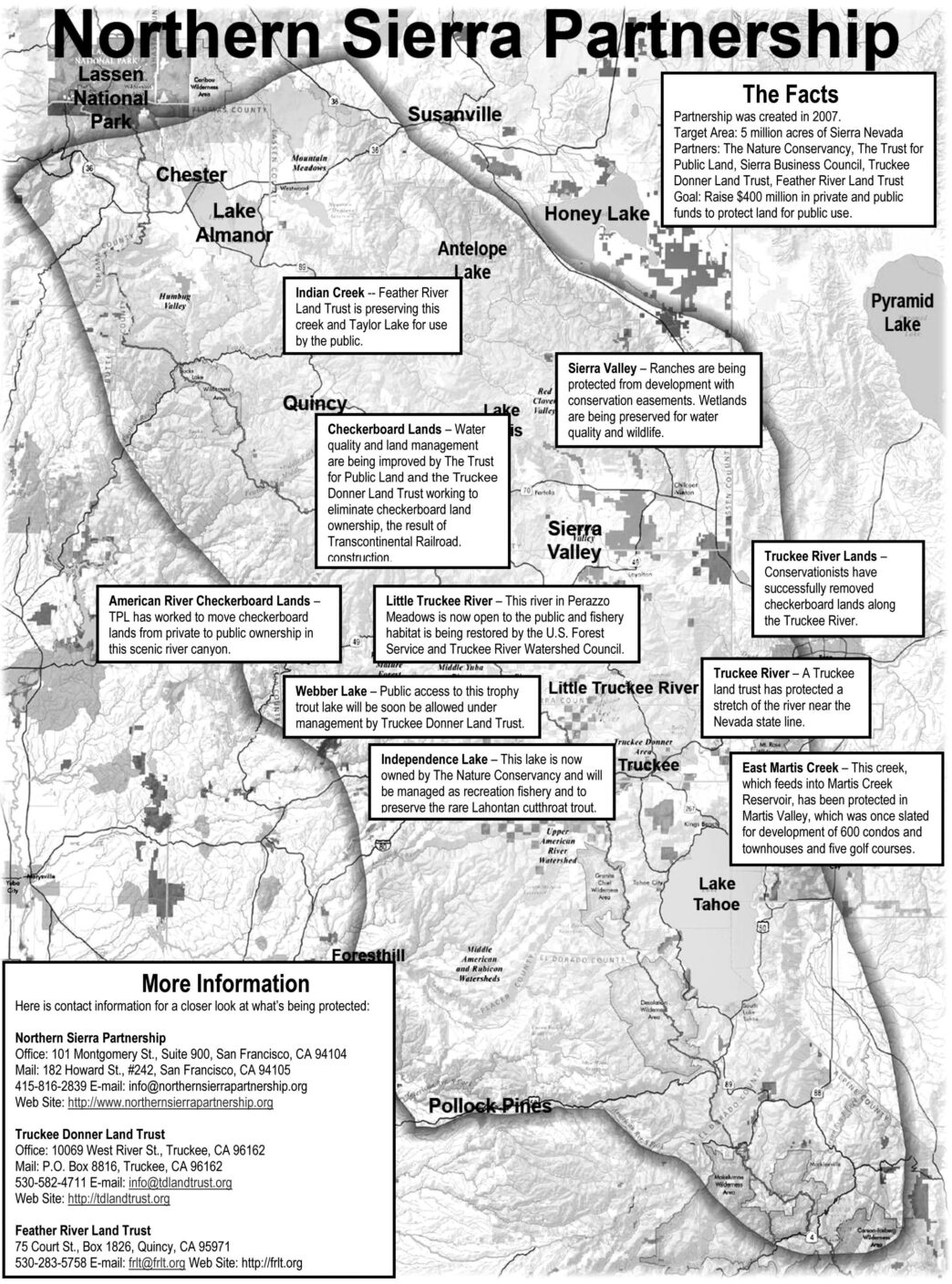You’ve likely fished it: the Sierra region that extends from Ebbetts Pass northward to the border of the Cascade Range. It’s an area that encompasses snow-capped peaks, pristine forests and meadows, and trout-filled streams and lakes. It’s an area that provides much of the water that California’s households, businesses, and farmers rely upon. And, given its proximity to the San Francisco, Sacramento, and Reno metropolitan areas, the northern Sierra is also a region where the pressure to develop land is inexorably rising.
The desire to turn forests and meadows into vacation homes and resorts has led conservationists to protect lands that have important ecological, recreational, and scenic values. One of the more ambitious organizations is the three-year-old Northern Sierra Partnership (http://www.northernsierrapartnership.org), a coalition that purchases key properties, manages them for public recreation or transfers their ownership to public agencies, and sponsors habitat restoration projects on the properties. Partners in this $400 million effort include The Nature Conservancy, The Trust for Public Land, the Truckee Donner Land Trust, the Feather River Land Trust, and the Sierra Business Council, a Truckee-based alliance of environmentally minded businesses.
The work of the Northern Sierra Partnership will not only keep lands from being developed, it will open public access to formerly private lands and waters and also improve habitat in waters that historically have fished poorly, such as the Little Truckee River in Perazzo Meadows, north of Truckee. “Fishing in the Little Truckee in Perazzo Meadows was — and is — dreadful,” said Perry Norris, executive director of the Truckee Donner Land Trust. “Federal funds have been gained to restore the river with pond and plug projects,” which redirect stream flow into stable, historical channels on the meadow’s surface and reconnect the channel to its floodplain, improving trout habitat over time. “It could be fishable by next summer.”
The Perazzo Meadows effort is just one example of partnership projects that help meet the group’s goals of improving access and helping the high-mountain environment. “At the Perazzo Meadows project, over two miles of the Little Truckee River meanders through a 982-acre mosaic of meadows and wetlands,” says a Northern Sierra Partnership briefing document on the project. “The waterways are rich in fish species native to the Lahontan Basin. Until the Northern Sierra Partnership took action, the Perazzo Meadows project was the last private parcel in the entire meadows complex. Perazzo Meadows has now been permanently protected for the public.”
The partnership raises private money and advocates for public funding to pay for the work of the land trusts, which identify and purchase key natural-resource lands from willing sellers. Some of these lands have been slated for development. Others are sold because owners need cash in a down economy. Still others, such as those in the rural Sierra Valley, are being sold by ranching families who want to retire.
The partnership enjoys the financial backing of the David and Lucille Packard Foundation, which donated $10 million to jump-start the land-saving effort. Private donors added another $10 million. With a three-person staff in San Francisco, the partnership has a goal of raising $100 million to convert land from private to public use. According to the Northern Sierra Partnership, that money will leverage $300 million in state and federal funds for land acquisition and restoration projects. The public funding effort has drawn the help of U.S. Senator Dianne Feinstein and Governor Arnold Schwarzenegger, who have provided support in Washington, D.C., Sacramento, and at events in the Sierra.
Five Million Acres
The area targeted for this land-saving effort includes a five-million-acre swath of the Sierra range bordered by Lassen Volcanic National Park on the north, Honey Lake on the east, Foresthill on the west, and the upper East Fork of the Carson River on the south. Areas within the Northern Sierra Partnership boundaries include the headwaters of the Feather, Yuba, American, Truckee, and Carson Rivers. According to Norris of the Truckeebased land trust, the partnership was created just as many key privately owned land parcels came up for sale. “Some of these properties haven’t been for sale for one hundred years,” he said, referring to stretches of the Little Truckee and lakes in or near Perazzo Meadows. In that area, landowners include power companies, an Oregon timber firm, a speculator from Kansas, and pioneering ranching families with aging owners and no children.
Land trusts such as Truckee Donner are able to work with the various owners to protect the properties from development by buying either the land or its development rights. The state has some 150 land trusts, according to the Sacramento-based California Council of Land Trusts, and many work with multiple property owners, acting as intermediaries for government agencies in protecting land for public use. Land trusts also work with single landowners.
Webber Lake
“Webber Lake, for instance, is owned by an elderly couple who want to see that the area isn’t developed and is preserved for public use,” said Norris, referring to the 250-acre lake in Sierra County. For over 150 years, the lake and its historic hotel have been operated as a private camping resort. The Webber Lake Hotel was built in 1860 and was a popular stagecoach stop during the Gold Rush era. It remains relatively unchanged today.
Both the San Francisco–based Trust for Public Land and the Truckee Donner Land Trust are under contract to purchase the lake, which includes the adjacent 1,900-acre Lacey Meadow. The lake and meadow form the headwaters of the Little Truckee River.
While the public will eventually own the lake, it will be managed by the Truckee Donner Land Trust, which will lease the campground until a long-term management plan is completed. The lake will eventually be opened to the public for fishing (expect a five-year wait). Webber has long been managed as a private trophy-trout fishery.
Norris also noted that the land trust is managing the forests in the area and has plans to expand a hiking trail system there and hook up with trails that lead to Mount Lola and the Pacific Crest Trail.
Independence Lake
Down the road from Webber Lake, The Nature Conservancy, in partnership with the Truckee Donner Land Trust and others, completed in April the $15 million purchase of Independence Lake, another privately owned body of water that supports one of the world’s last two remaining wild lake populations of Lahontan cutthroat trout. “The conservancy purchased 2,325 acres of forest lands surrounding Independence Lake for $15 million from Nevada Energy, a utility company that has been a steward of the lake since 1937,” states a Northern Sierra Partnership press release on the deal. “Visitors have flocked to Independence Lake since the 1800s, and its fairy-tale alpine setting has also intrigued developers interested in pursuing a luxury resort or a private estate.” The Disney Corporation had once proposed building a large resort development and ski area at the lake, which has limited access down a bumpy dirt road that connects with the paved Forest Route 07 (also know as the Jackson Meadows Road, which hits Highway 89 to the east). The Nature Conservancy has opened Independence Lake for day use and intends to open its campground to the public in 2011. The Nature Conservancy and the Truckee Donner Land Trust are writing a long-term management plan for the lake and its lands. In the interim, angling will be managed to protect the rare cutthroat trout, and options may include possible eradication of resident brook and rainbow trout.
East Martis Creek
As part of the Northern Sierra Partnership, The Trust for Public Land and the Truckee Donner Land Trust purchased, in 2007, the 1,482-acre Waddle Ranch, a key area for protecting trout waters and curbing development in Martis Valley just south of Truckee. The Martis Valley Community Plan, adopted by Placer County in 2004, calls for the construction of thousands of housing units in the area that forms the upper watershed for Martis Creek Reservoir, the state’s first catch-and-release water. Waddle Ranch had been designated by the plan for significant residential development.
East Martis Creek flows through the property now owned by the Truckee Tahoe Airport District with a conservation easement held by the land trust, which is doing restoration work and improving facilities for outdoor recreation. Although the stream is closed to fishing, it is a tributary to Martis Creek, the primary feeder to the reservoir.
Fly fishers should know, however, that Martis Creek Reservoir is currently suffering from the growth of milfoil, an invasive aquatic plant that robs the water of oxygen and that has resulted in fish kills in other lakes. Working with fly-fishing clubs and volunteer scuba divers, government agencies are undertaking an innovative project to lay down underwater tarpaulins to cut off the light and kill the milfoil. The eradication method has been used with limited success in Lake Tahoe.
Indian Creek, Taylor Lake
Farther to the north, the Feather River Land Trust has been working with the Northern Sierra Partnership to open to the public the former Heart K Ranch and one and one-half miles of Indian Creek. The creek, which has a thriving population of brown and rainbow trout, is located in the Genesee Valley, west of Antelope Lake in the Plumas National Forest.
According to Jason Moghaddas, conservation director for the land trust, the group purchased the 884-acre ranch property for $2.5 million. As part of the ranch project, the Nature Conservancy also purchased 80-acre Taylor Lake, a pretty impoundment with crystal-clear water and a healthy population of feisty but shy brook trout. The land trust received $1.5 million from the partnership to purchase the property, Moghaddas said, and fundraising efforts are underway to raise the remaining $1 million.
Most of the work of the 10-year-old Quincy-based land trust has focused on protecting ranch land from development in the Sierra Valley, but the group has also acquired land to protect the headwaters of the Middle Fork of the Feather River and a 450-acre property that provides access to the Little Truckee River.
Checkerboard Lands
As part of the partnership, the Trust for Public Land has launched its Checkerboard Initiative, which is aimed at private land holdings that have been scattered through the Sierra since the pioneering railroading days. “In 1863, with the Civil War raging in the southern U.S., the federal government started construction of the Transcontinental Railroad over a dangerous northern route crossing Donner Summit,” says a Northern Sierra Partnership briefing paper on the initiative. “As an incentive to the railroad companies, the government granted them ownership of every other square mile of land along a 20-mile corridor. This policy created a checkerboard pattern of alternative public and private ownership that remains today.”
Many of these private checkerboard holdings are owned by timber companies that have been selling them to private developers. The Trust for Public Land’s nine-year-old initiative is working to transfer these fragmented private holdings to the U.S. Forest Service for better management and to improve water quality in rivers and streams. To date, over 2,500 acres of checkerboard lands along the North Fork of the American River, near Independence Lake, and in the Truckee River watershed have been transferred to public ownership.
The partnership’s work will pay dividends for fly fishers over time. All it takes, though, is money.
















